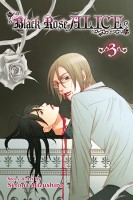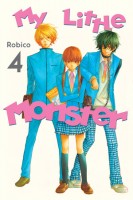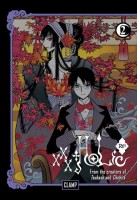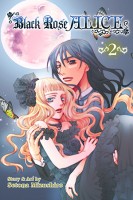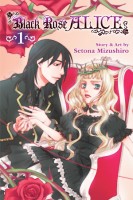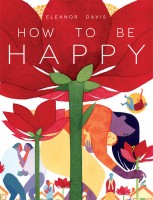My News and Reviews
Only one in-depth review was posted at Experiments in Manga last week. I should be getting back to my regular blogging schedule very soon, though. As for the said review, I took a look at Setona Mizushiro’s After School Nightmare, Volume 7 as part of my monthly horror manga review project. After School Nightmare is an effectively unsettling work, but it’s also engrossing. The seventh volume has some particularly chilling developments and revelations. (And that’s it from me at the moment!)
Quick Takes
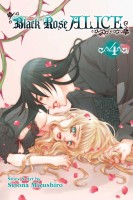 Black Rose Alice, Volumes 4-6 by Setona Mizushiro. From what I can tell, Black Rose Alice is currently on hiatus in Japan. Fortunately, the first six volumes appear to complete the first major story arc of the manga. While I certainly hope that the Black Rose Alice continues, and I look forward to seeing how it develops, at least readers are provided with some resolution and closure for what could be a long wait. This second half of the first arc deals with the aftermath of Leo’s demise. The relationship dynamics in Black Rose Alice have always been a little peculiar and unnerving, but as they begin to fracture under the strain of the loss of Leo it’s shown just how strong and just how tenuous they can be at the same time. These volumes also include the reappearance of Koya, which throws the situation into even more turmoil, and the revelation of the twins tragic backstory. Emotions run high and the drama is intense as everything seems to be falling apart. Black Rose Alice continues to be dark and creepy and Mizushiro’s vampires are still some of the most unusual ones that I’ve come across.
Black Rose Alice, Volumes 4-6 by Setona Mizushiro. From what I can tell, Black Rose Alice is currently on hiatus in Japan. Fortunately, the first six volumes appear to complete the first major story arc of the manga. While I certainly hope that the Black Rose Alice continues, and I look forward to seeing how it develops, at least readers are provided with some resolution and closure for what could be a long wait. This second half of the first arc deals with the aftermath of Leo’s demise. The relationship dynamics in Black Rose Alice have always been a little peculiar and unnerving, but as they begin to fracture under the strain of the loss of Leo it’s shown just how strong and just how tenuous they can be at the same time. These volumes also include the reappearance of Koya, which throws the situation into even more turmoil, and the revelation of the twins tragic backstory. Emotions run high and the drama is intense as everything seems to be falling apart. Black Rose Alice continues to be dark and creepy and Mizushiro’s vampires are still some of the most unusual ones that I’ve come across.
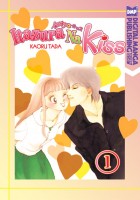 Itazura na Kiss, Volumes 1-3 by Kaoru Tada. Considering the number of boys’ love titles that Digital Manga releases in print (as well as its recent efforts to translate all of Osamu Tezuka’s works and its foray into hentai) it can be easy to forget that the publisher has other interesting manga in its catalog, too. Itazura na Kiss is one such series, a classic shoujo manga from the nineties which was extremely successful in Japan and elsewhere in Asia. The story is about Kotoko, an academically-challenged young woman in high school who has fallen in love Naoki, another student who is a legitimate genius. He also turns out to be a huge jerk, but every once in a while he shows a warmer, kinder side of himself. So far, I have been enjoying Itazura na Kiss, perhaps more than I expected. Kotoko shows wonderful strength of character and even Naoki’s unpleasant personality has more depth to it than initially appears. Despite the best efforts of their parents who would love to see them married, the romance between the two of them is believably slow to develop. I also like that the story doesn’t get stuck in high school and follows Naoki and Kotoko as they enter college.
Itazura na Kiss, Volumes 1-3 by Kaoru Tada. Considering the number of boys’ love titles that Digital Manga releases in print (as well as its recent efforts to translate all of Osamu Tezuka’s works and its foray into hentai) it can be easy to forget that the publisher has other interesting manga in its catalog, too. Itazura na Kiss is one such series, a classic shoujo manga from the nineties which was extremely successful in Japan and elsewhere in Asia. The story is about Kotoko, an academically-challenged young woman in high school who has fallen in love Naoki, another student who is a legitimate genius. He also turns out to be a huge jerk, but every once in a while he shows a warmer, kinder side of himself. So far, I have been enjoying Itazura na Kiss, perhaps more than I expected. Kotoko shows wonderful strength of character and even Naoki’s unpleasant personality has more depth to it than initially appears. Despite the best efforts of their parents who would love to see them married, the romance between the two of them is believably slow to develop. I also like that the story doesn’t get stuck in high school and follows Naoki and Kotoko as they enter college.
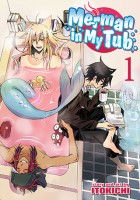 Merman in My Tub, Volume 1 by Itokichi. Seven Seas has made something of a name for itself as the publisher of monster girl manga, but with Merman in My Tub monster boys are now better represented as well. The basic and appropriately ridiculous premise of Merman in My Tub is that Wakasa, a merman, has become a permanent resident in the bathtub of Tatsumi, a young man who rescued him from a polluted river. His mere presence causes all sorts of problems and inconveniences for Tatsumi, especially when his other aquatic acquaintances begin showing up, too. The series is a largely episodic four-panel comedy manga although there are some small story arcs, recurring characters, and running jokes. There is also plenty of boys’ love tease and innuendo. (In part Itokichi seems to have created the series as an excuse to draw half-naked men.) At the same time, Merman in My Tub makes use of some of the vaguely incestuous little sister/big brother tropes that can be fairly prevalent these days. As a result, though it has its charm, the series sometimes seems a little confused about which audience it’s trying to appeal to.
Merman in My Tub, Volume 1 by Itokichi. Seven Seas has made something of a name for itself as the publisher of monster girl manga, but with Merman in My Tub monster boys are now better represented as well. The basic and appropriately ridiculous premise of Merman in My Tub is that Wakasa, a merman, has become a permanent resident in the bathtub of Tatsumi, a young man who rescued him from a polluted river. His mere presence causes all sorts of problems and inconveniences for Tatsumi, especially when his other aquatic acquaintances begin showing up, too. The series is a largely episodic four-panel comedy manga although there are some small story arcs, recurring characters, and running jokes. There is also plenty of boys’ love tease and innuendo. (In part Itokichi seems to have created the series as an excuse to draw half-naked men.) At the same time, Merman in My Tub makes use of some of the vaguely incestuous little sister/big brother tropes that can be fairly prevalent these days. As a result, though it has its charm, the series sometimes seems a little confused about which audience it’s trying to appeal to.

